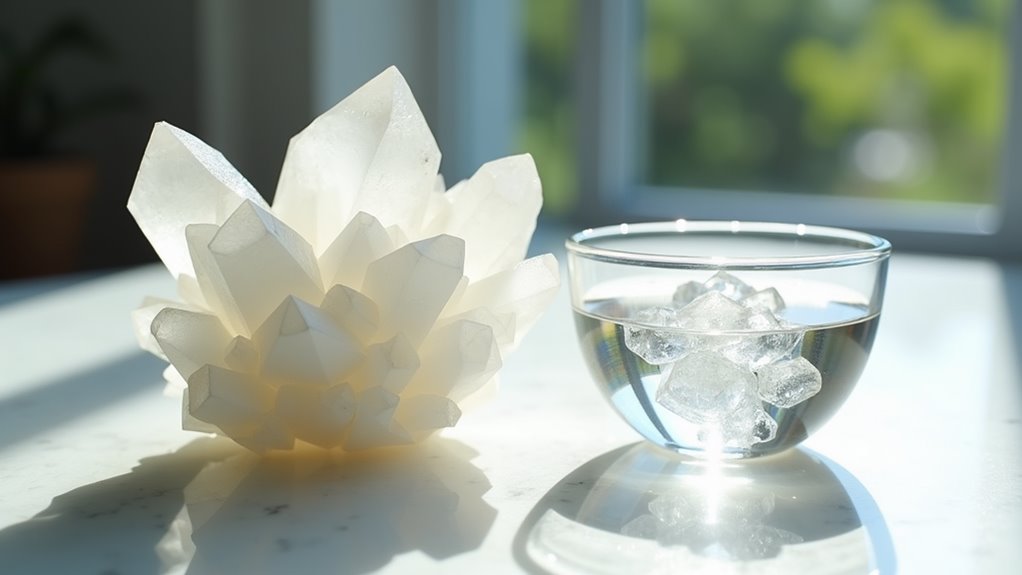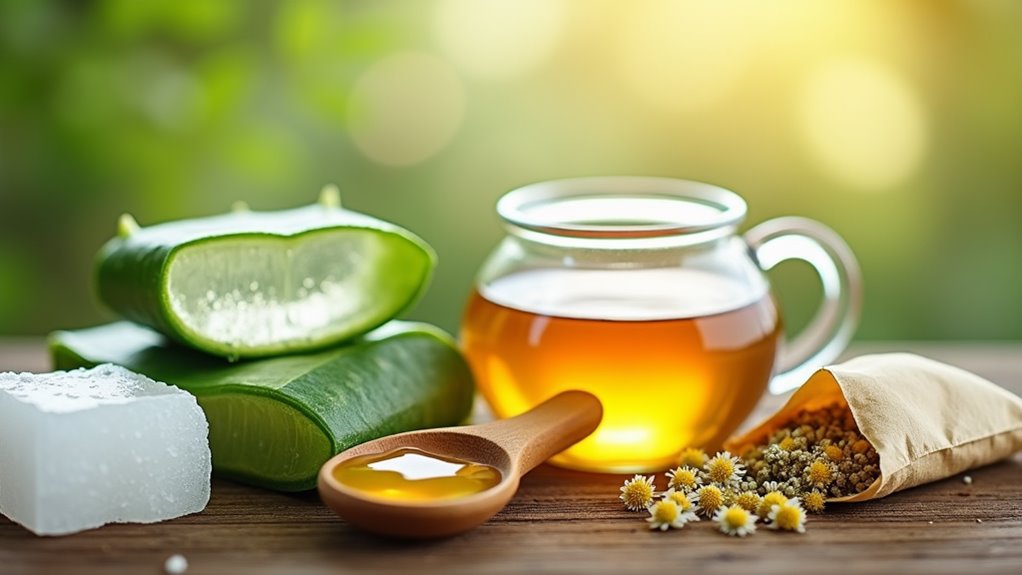Knee Pain No More- 7 Natural Remedies to Get You Moving Again!
You can find natural relief from knee pain through seven proven remedies. Start with anti-inflammatory foods like berries and fatty fish, then incorporate gentle stretches like wall sits and hamstring stretches. Apply natural topicals such as ginger oil or turmeric paste, and use hot/cold therapy strategically. Don’t forget mind-body practices like yoga and meditation. These holistic approaches, combined with lifestyle changes, will help you rediscover pain-free movement and lasting comfort.
What Causes Common Knee Pain?
Knee pain affects millions of people worldwide and can stem from various underlying causes. If you’re experiencing discomfort in your knees, you’re not alone – many people are seeking knee pain relief remedies for similar conditions.
Your knee pain might be due to osteoarthritis, the most common form of joint deterioration that occurs with age. Other frequent causes include injuries to ligaments, such as ACL tears during sports activities, or meniscus damage from sudden twisting movements.
You may also develop knee pain from overuse, particularly if you’re a runner or participate in high-impact activities. Poor posture, excess weight, and inflammatory conditions like rheumatoid arthritis can contribute to your knee discomfort. Additionally, anti-inflammatory foods can significantly reduce knee pain, making dietary adjustments a valuable part of your treatment approach.
Understanding what’s causing your pain is crucial before trying natural remedies, as different causes require different approaches to treatment. Some knee pain may also result from muscle imbalances or wearing inappropriate footwear during activities.
The Power of Anti-inflammatory Foods
Did you know that certain foods can naturally combat joint inflammation? When you’re dealing with knee pain, what you eat can make a significant difference in how you feel. By incorporating anti-inflammatory foods into your diet, you’ll help reduce swelling and discomfort in your knees.
Start by adding colorful berries like blueberries and strawberries to your meals. They’re packed with antioxidants that fight inflammation.
Fatty fish such as salmon and mackerel contain omega-3s that can ease your joint pain. You’ll also want to include turmeric, ginger, and garlic in your cooking – these powerful spices have been used for centuries to reduce inflammation.
Don’t forget to load up on leafy greens like spinach and kale, which are rich in vitamin K and antioxidants.
Green tea is another excellent choice, as it contains compounds that help block inflammatory substances in your body. To maximize benefits, try incorporating omega-3 rich foods into your diet, as they can significantly combat inflammation.
Try replacing processed foods with these natural alternatives to support your knee health.
Essential Stretches and Exercises for Knee Relief
When your knee pain flares up, gentle stretching and targeted exercises can provide significant relief while building strength in the supporting muscles. You’ll want to focus on movements that increase flexibility and stability without causing additional strain. Regular practice of these exercises can help improve overall knee health and reduce discomfort over time.
| Exercise | How to Do It |
|---|---|
| Wall Sits | Stand against wall, slide down to 45°, hold 30 seconds |
| Hamstring Stretch | Sit with leg extended, reach for toes, hold 20 seconds |
| Heel Raises | Stand on step edge, lift heels up and down slowly |
| Straight Leg Raises | Lie back, lift straight leg 45°, hold 5 seconds |
| Mini Squats | Stand hip-width apart, bend knees slightly, repeat |
Start with these exercises daily, focusing on proper form rather than repetitions. If you’re experiencing chronic knee pain, it’s best to work with a physical therapist who can customize your routine and ensure you’re performing each movement correctly. Remember to warm up beforehand and stop if you feel sharp pain.
Natural Topical Remedies and Herbal Solutions
Along with exercise, several natural topical treatments and herbs can help reduce knee discomfort and inflammation. You’ll find relief by applying cold-pressed ginger oil, which penetrates deeply to ease joint pain.
Turmeric paste, when mixed with coconut oil, creates a powerful anti-inflammatory treatment you can massage directly onto your knee.
Many people in your situation have found success with arnica gel, a traditional remedy that reduces swelling and bruising.
Try peppermint essential oil, diluted in a carrier oil, for its cooling effect and pain-relieving properties. For an extra boost, combine these treatments with oral supplements like glucosamine and boswellia.
You can also prepare a warm compress using chamomile tea bags or create a cayenne pepper paste – both trusted remedies in natural healing communities. Additionally, incorporating natural anti-inflammatory foods into your diet can further enhance your pain relief efforts.
These solutions work best when you apply them consistently and combine them with your regular exercise routine.
Hot and Cold Therapy Techniques
Two fundamental approaches to managing knee pain involve hot and cold therapy techniques.
You’ll want to apply cold therapy immediately after an injury or when inflammation flares up. Use an ice pack wrapped in a thin towel for 15-20 minutes at a time, several times throughout the day. This helps reduce swelling and numbs the area to provide relief.
Heat therapy works best for chronic knee pain and stiffness, especially before activities. You can use a heating pad, warm compress, or take a warm bath for 15-20 minutes to increase blood flow and loosen tight muscles.
Many people find alternating between hot and cold treatments particularly effective. Consistent practice of these exercises can enhance the benefits of these therapies and improve overall knee health.
For optimal results, remember to protect your skin by never applying ice or heat directly.
You’re also part of a community that understands timing matters – use cold therapy within 48 hours of an acute injury, then transition to heat for ongoing comfort and mobility.
Lifestyle Changes to Protect Your Knees
Making strategic lifestyle adjustments can significantly reduce knee pain and prevent future injuries. If you’re carrying extra weight, start with a gradual weight loss plan to reduce stress on your knees. Every pound lost means four pounds less pressure on your joints when you walk.
You’ll want to modify your daily movements to protect your knees. When climbing stairs, lead with your stronger leg going up and your weaker leg going down. Choose low-impact exercises like swimming or cycling instead of running on hard surfaces.
If you sit at a desk all day, get up every hour to prevent stiffness. Don’t forget to wear supportive shoes with good shock absorption, and replace them before they’re worn out. When standing, keep your feet shoulder-width apart to distribute weight evenly. Incorporating gentle stretching into your routine can further enhance flexibility and support knee health.
These simple changes, combined with maintaining proper posture throughout the day, will help safeguard your knees for years to come.
Alternative Therapies and Mind-Body Practices
While conventional treatments remain popular, several alternative therapies can effectively manage knee pain. You’ll find relief through acupuncture, which targets specific points to reduce inflammation and discomfort.
Many people in your situation have also discovered the benefits of therapeutic massage, which improves circulation and releases tension in the surrounding muscles.
Mind-body practices like yoga and tai chi can strengthen your knee joints while promoting flexibility and balance. These gentle exercises connect you with others who share similar challenges.
You’ll learn proper breathing techniques and mindfulness practices that help manage pain perception and reduce stress.
Consider joining a meditation group focused on pain management – you’ll gain valuable coping strategies while building a supportive network.
Aromatherapy with essential oils like peppermint and eucalyptus can complement these practices, creating a holistic approach to knee pain relief that addresses both physical and emotional well-being. Additionally, essential oils can naturally ease discomfort associated with various ailments, enhancing your overall wellness journey.
Frequently Asked Questions
How Long Should I Wait After Knee Injury Before Returning to Sports?
You’ll need to wait until you’re pain-free and have full mobility, typically 2-8 weeks depending on injury severity. Always check with your doctor before returning to sports.
Can Wearing High Heels Contribute to Chronic Knee Problems?
You’re right to be concerned! High heels shift your weight forward, stressing your knees and changing your gait. Regular wear can lead to joint problems and worsen existing knee conditions.
At What Age Do Most People Start Experiencing Recurring Knee Pain?
You’ll likely notice recurring knee pain starting in your 40s or 50s, but don’t worry – it’s common among your peers as natural aging affects joint cartilage and muscle strength.
Should I Consider Losing Weight if I Have Frequent Knee Pain?
You’ll definitely want to lose weight if you’re experiencing knee pain, as every extra pound puts 4-6 pounds of pressure on your knees. Even modest weight loss can help.
Are There Specific Shoes or Insoles Recommended for Knee Pain Relief?
You’ll want supportive shoes with good shock absorption and arch support. Consider orthotic insoles designed for your specific foot type and walking pattern to reduce knee stress.





